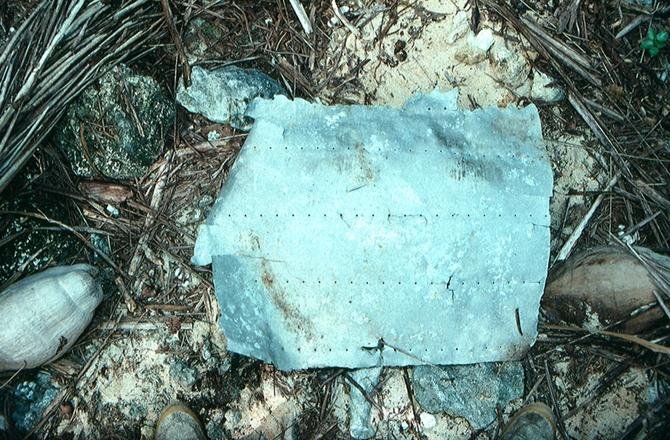1 of 5 | New research suggests that a piece of aluminum aircraft debris recovered in 1991 from Nikumaroro, an uninhabited atoll in the southwestern Pacific republic of Kiribati, does belong to Earhart’s twin-engined Lockheed "Electra" (TIGHAR)
OXFORD, Pa., Oct. 29 (UPI) -- Researchers hunting for Amelia Earhart's lost plane believe they have identified a piece of the aircraft for the very first time since her disappearance.
An aluminum fragment discovered on the uninhabited Pacific atoll Nikumaroro in 1991, near where Earhart disappeared on in 1937, has been identified "with a high degree of certainty" as part of Earhart's Lockheed Electra.
Earhart took off from Miami on June 1, 1937, officially kicking off her second attempt to circumnavigate the world. On July 2, 1937, she took off from Lae, New Guinea, with just 7,000 miles to go, and disappeared.
According to researchers at The International Group for Historic Aircraft Recovery, which is dedicated to locating Earhart's plane, the fragment is very likely a patch installed as quick fix to replace a custom-made window on her plane.
"During Amelia Earhart's stay in Miami at the beginning of her second world flight attempt, a custom-made, special window on her Lockheed Electra aircraft was removed and replaced with an aluminum patch," TIGHAR executive director Ric Gillespie said in a statement.
"The patch was an expedient field modification. Its dimensions, proportions, and pattern of rivets were dictated by the hole to be covered and the structure of the aircraft," Gillespie explained. "The patch was as unique to her particular aircraft as a fingerprint is to an individual."
Nikumaroro has become the center of TIGHAR's search for Earhart's missing craft, which researchers have long speculated is where she and navigator Fred Noonan may have been forced to make an emergency landing en route to Howland Island, approximately 350 miles northwest.
In a series of 10 expeditions to the area, TIGHAR has located a number of artifacts, including the "Miami Patch." Then last year, TIGHAR announced the discovery of an "anomaly" on sonar images taken in the waters off Nikumaroro that they believed could be the fuselage of the Electra.
TIGHAR believe Earhart landed safely on a reef at Nikumaroro and sent distress calls for at least five days before the plane washed into the ocean, stranding her and Noonan. The fragment, which was discovered washed up on the shore, could have been broken away from the plane as it broke apart underwater on the reef.
"The artifact is not, as previously suspected, a random fragment from an aircraft shredded by the surf, and its removal from the aircraft appears to have been due, at least in part, to human action," Gillespie said. "That could only happen if the patch was broken out when the aircraft was on the reef surface -- but when and by whom? Somehow the patch/artifact ended up on the island, so it must have either washed or been carried ashore."
The anomaly, resting 600 feet down, will be examined by TIGHAR's Remote Operated Vehicle on the group's next expedition to Nikumaroro, in June 2015. It stands out from the rest of the ocean floor as apparently man-made, and appears to be the correct size and shape to be the fuselage.
"The new research on [the fragment] may reinforce the possibility that the anomaly is the rest of the aircraft," Gillespie said. "The only way to know is to go look."















